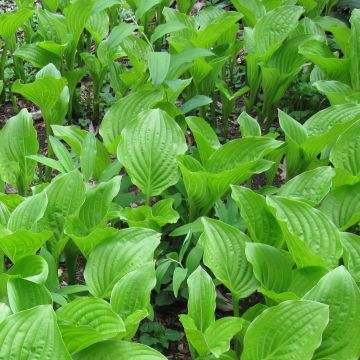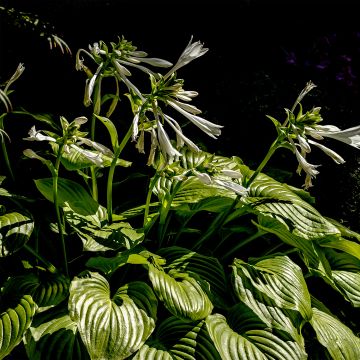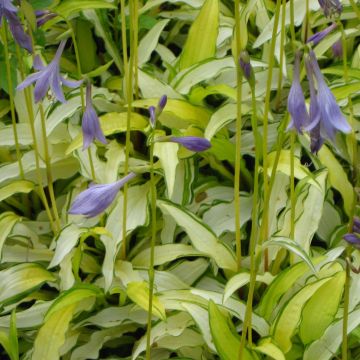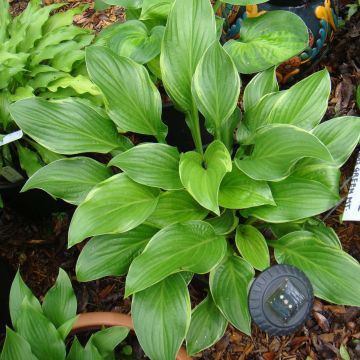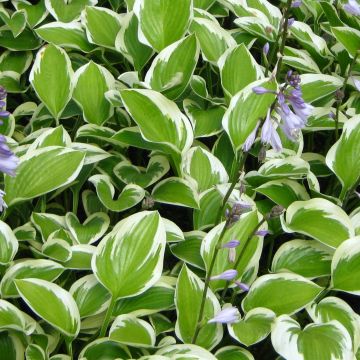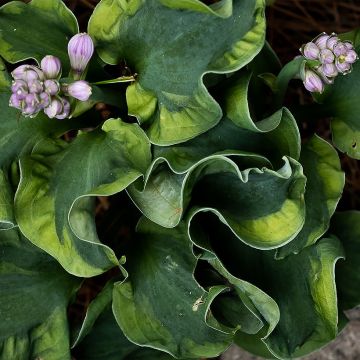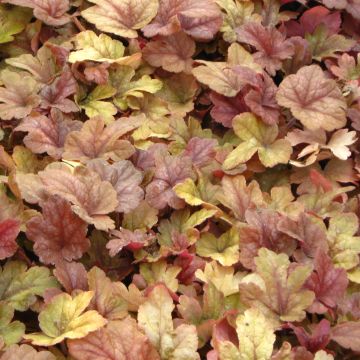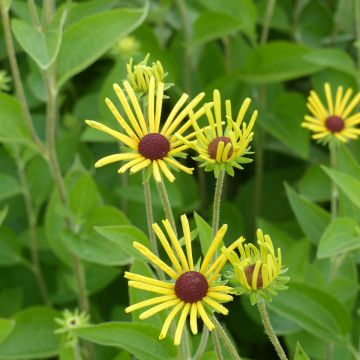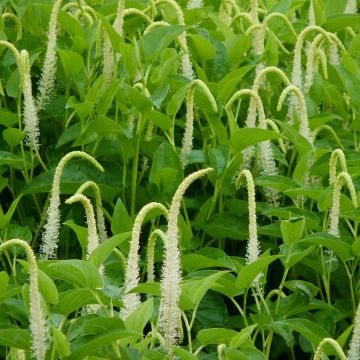

Hosta True Blue
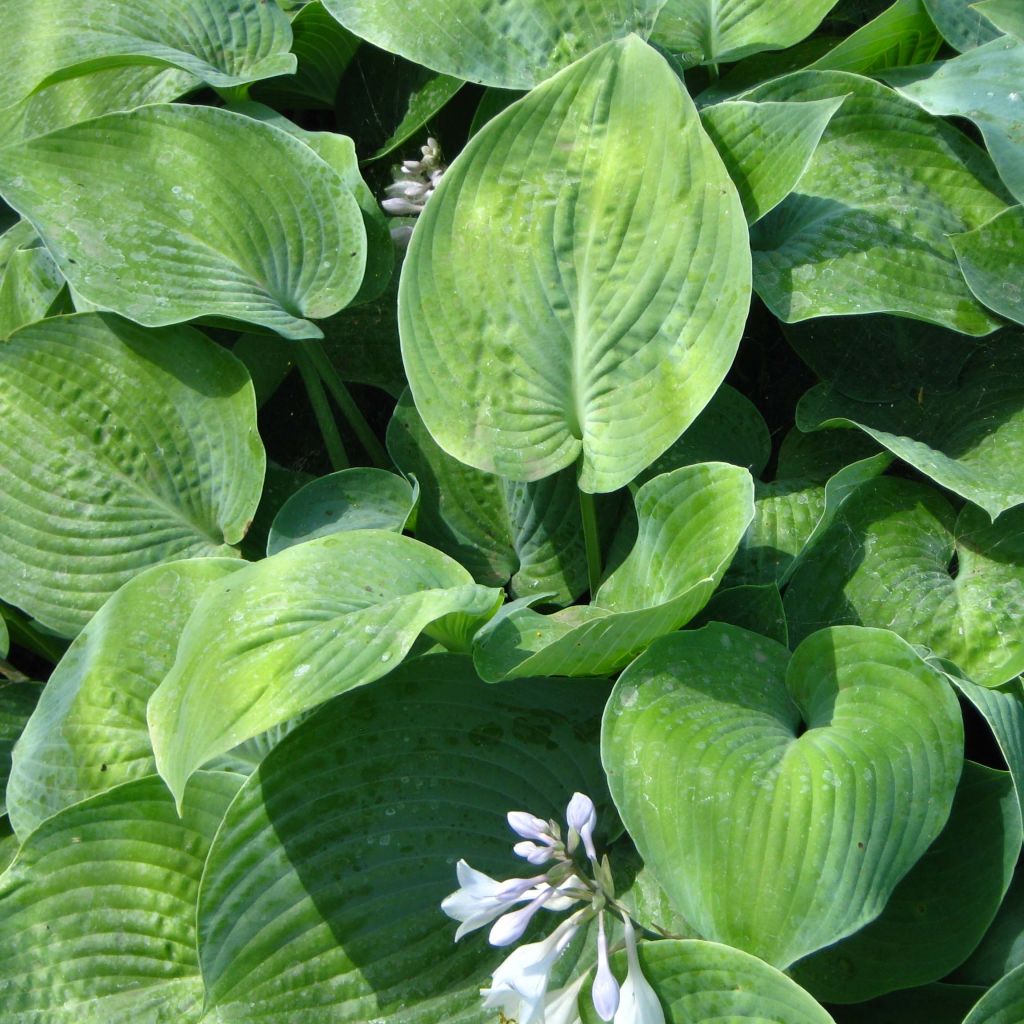

Hosta True Blue
Hosta True Blue
Hosta True Blue
Plantain Lily, Funkia
The three young plants have recovered well and have grown rapidly. The flowers that bloomed at the end of summer are an additional delight.
Delphine P., 16/10/2020
Why not try an alternative variety in stock?
View all →This plant carries a 12 months recovery warranty
More information
We guarantee the quality of our plants for a full growing cycle, and will replace at our expense any plant that fails to recover under normal climatic and planting conditions.
From €5.90 for pickup delivery and €6.90 for home delivery
Express home delivery from €8.90.
Does this plant fit my garden?
Set up your Plantfit profile →
Description
Hosta 'True Blue' is a variety with large and wide leaves strongly embossed with a very intense pruinose blue! It is a hybrid of H. sieboldiana with even bluer leaves. The foliage is thick, cordate, deeply wrinkled, and fabulously rough. In mid-summer, almost white pendulous bell-shaped spikes discreetly crown its foliage. It has a medium growth rate and shows good resistance to slugs. This deciduous perennial forms a large, slightly arched clump that remains decorative from spring to autumn. It is a versatile plant, perfect for borders, ground cover, pots, or structuring perennial beds. Easy to grow, plant it in shade or partial shade in moist, well-drained, average to rich soil.
The Hosta, or Funkia, is a deciduous perennial that is very hardy and produces its leafy clump from spring onwards. It belongs to the asparagus family. With a medium growth rate, the Hosta 'True Blue' forms a compact bushy cushion reaching 60cm (24in) in height and 100cm (39in) in spread. It is a long-lived plant with large cordate leaves, deeply wrinkled, with undulating margins, forming slightly cupped shapes about 31cm (12in) tall and 26cm (10in) wide, with pointed tips. Its lamina is pleated by 16 pairs of very deep veins. Its very tough leaves are resistant to slugs. From the heart of its bluish foliage emerge from July to August tall flower spikes, about 75-80cm (30-32in) in height, bearing racemes of bell-shaped flowers, not very fragrant.
Hostas like moist, well-drained, and rich soils, and dislike drought and scorching exposures. A location exposed to afternoon sun should be avoided, as it can burn the leaves of these perennials. In hotter and drier regions, provide a thick mulch. Hostas, with their generous and decorative foliage, are perfect as ground cover, in borders, or in partially shaded to shaded beds, where other plants struggle to grow. They like sheltered and moist locations such as woodlands. Varieties with bluish and green foliage tolerate dense shade better. Sun tends to make blue colours turn green. Lighter foliage thrives in partial shade, where their colour transforms and lightens with increased sunlight. In general, morning sun exposure allows optimal development of these perennials and also makes them more floriferous. Gastropods (slugs and snails) are particularly fond of these fleshy perennials, so contemporary hybridisations aim to create hostas that are increasingly resistant to their attacks.
Combine them in groups with other hostas, ferns, delphiniums, Solomon's seal, and other low ground cover perennials such as creeping bugles, geraniums, and lamiums. All are very effective as slug repellents. The silver-leaved Brunnera macrophylla Mr Morse will be excellent companions. Also consider Heucheras with their wonderful range of colours or the delicate flowers of Epimediums. Golden foliage contrasts beautifully with their red and orange shades. These combinations will allow you to enhance darker and slightly damp areas of the garden, creating a pleasant haven of shade for the summer. Hostas also thrive in pots that should be placed in partial shade and watered regularly. Hostas pair wonderfully with spring bulbs that appear in late spring, just in time to cover faded plants with their generous foliage! Around a pond, plant them with persicarias, sedges, and astilbes. The blue foliage harmonises perfectly with the red and purple foliage of Japanese maples.
Did you know: Most of the species commonly found in Western gardens have been introduced from Japan. Hostas are edible and are called urui in Japan, where they are commonly consumed.
Report an error about the product description
Hosta True Blue in pictures


Flowering
Foliage
Plant habit
Botanical data
Hosta
True Blue
Liliaceae - Hostaceae
Plantain Lily, Funkia
Cultivar or hybrid
Other Hostas - Plantain Lilies
Planting and care
Hostas are planted in spring or autumn. Hostas prefer deep, fertile, humus-rich, loose soil, preferably neutral to acid (at least low in limestone), moist to wet throughout the year. Place them in partial shade or dappled shade and in a sheltered location away from strong winds.
Prepare a planting hole of 20cm (8in) x 20cm (8in) x 20cm (8in). If your soil is heavy, mix half compost with crumbled soil, partially fill the hole and place your potted plant so that the top of the root ball is covered with 3cm (1in) of soil. The application of a base fertiliser (such as bonemeal) will nourish your plant during its rooting period without the risk of burning. Make sure to position the collar well above ground level. Firmly pack the soil and water generously to eliminate air pockets. If the weather is dry, regular watering will be necessary for a few weeks to facilitate the establishment of your plant. Also, water regularly during dry summers.
With their common preference for moist areas, slugs and snails never stay far from hostas. Even though blue or variegated hostas often have thicker and tougher foliage, which is less appealing to slugs, these plants should be protected from gastropods. Protect your Hostas by surrounding them with ferramol-based pellets (approved for Organic Agriculture), eggshells, coffee grounds, mulch, or any dry and rough natural substance that repels them. Hedgehogs are the gardener's best allies in the fight against gastropods, as unlike chickens, they do not dig up soil and do not attack the tender green shoots of young plants. Finally, some plants have a repulsive odour for slugs, such as wormwood and garlic.
Planting period
Intended location
Care
-
, onOrder confirmed
Reply from on Promesse de fleurs
Summer flowering perennials
Haven't found what you were looking for?
Hardiness is the lowest winter temperature a plant can endure without suffering serious damage or even dying. However, hardiness is affected by location (a sheltered area, such as a patio), protection (winter cover) and soil type (hardiness is improved by well-drained soil).

Photo Sharing Terms & Conditions
In order to encourage gardeners to interact and share their experiences, Promesse de fleurs offers various media enabling content to be uploaded onto its Site - in particular via the ‘Photo sharing’ module.
The User agrees to refrain from:
- Posting any content that is illegal, prejudicial, insulting, racist, inciteful to hatred, revisionist, contrary to public decency, that infringes on privacy or on the privacy rights of third parties, in particular the publicity rights of persons and goods, intellectual property rights, or the right to privacy.
- Submitting content on behalf of a third party;
- Impersonate the identity of a third party and/or publish any personal information about a third party;
In general, the User undertakes to refrain from any unethical behaviour.
All Content (in particular text, comments, files, images, photos, videos, creative works, etc.), which may be subject to property or intellectual property rights, image or other private rights, shall remain the property of the User, subject to the limited rights granted by the terms of the licence granted by Promesse de fleurs as stated below. Users are at liberty to publish or not to publish such Content on the Site, notably via the ‘Photo Sharing’ facility, and accept that this Content shall be made public and freely accessible, notably on the Internet.
Users further acknowledge, undertake to have ,and guarantee that they hold all necessary rights and permissions to publish such material on the Site, in particular with regard to the legislation in force pertaining to any privacy, property, intellectual property, image, or contractual rights, or rights of any other nature. By publishing such Content on the Site, Users acknowledge accepting full liability as publishers of the Content within the meaning of the law, and grant Promesse de fleurs, free of charge, an inclusive, worldwide licence for the said Content for the entire duration of its publication, including all reproduction, representation, up/downloading, displaying, performing, transmission, and storage rights.
Users also grant permission for their name to be linked to the Content and accept that this link may not always be made available.
By engaging in posting material, Users consent to their Content becoming automatically accessible on the Internet, in particular on other sites and/or blogs and/or web pages of the Promesse de fleurs site, including in particular social pages and the Promesse de fleurs catalogue.
Users may secure the removal of entrusted content free of charge by issuing a simple request via our contact form.
The flowering period indicated on our website applies to countries and regions located in USDA zone 8 (France, the United Kingdom, Ireland, the Netherlands, etc.)
It will vary according to where you live:
- In zones 9 to 10 (Italy, Spain, Greece, etc.), flowering will occur about 2 to 4 weeks earlier.
- In zones 6 to 7 (Germany, Poland, Slovenia, and lower mountainous regions), flowering will be delayed by 2 to 3 weeks.
- In zone 5 (Central Europe, Scandinavia), blooming will be delayed by 3 to 5 weeks.
In temperate climates, pruning of spring-flowering shrubs (forsythia, spireas, etc.) should be done just after flowering.
Pruning of summer-flowering shrubs (Indian Lilac, Perovskia, etc.) can be done in winter or spring.
In cold regions as well as with frost-sensitive plants, avoid pruning too early when severe frosts may still occur.
The planting period indicated on our website applies to countries and regions located in USDA zone 8 (France, United Kingdom, Ireland, Netherlands).
It will vary according to where you live:
- In Mediterranean zones (Marseille, Madrid, Milan, etc.), autumn and winter are the best planting periods.
- In continental zones (Strasbourg, Munich, Vienna, etc.), delay planting by 2 to 3 weeks in spring and bring it forward by 2 to 4 weeks in autumn.
- In mountainous regions (the Alps, Pyrenees, Carpathians, etc.), it is best to plant in late spring (May-June) or late summer (August-September).
The harvesting period indicated on our website applies to countries and regions in USDA zone 8 (France, England, Ireland, the Netherlands).
In colder areas (Scandinavia, Poland, Austria...) fruit and vegetable harvests are likely to be delayed by 3-4 weeks.
In warmer areas (Italy, Spain, Greece, etc.), harvesting will probably take place earlier, depending on weather conditions.
The sowing periods indicated on our website apply to countries and regions within USDA Zone 8 (France, UK, Ireland, Netherlands).
In colder areas (Scandinavia, Poland, Austria...), delay any outdoor sowing by 3-4 weeks, or sow under glass.
In warmer climes (Italy, Spain, Greece, etc.), bring outdoor sowing forward by a few weeks.








































